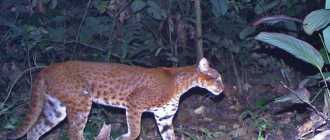There are many amazing creatures living on our planet, but some of them can simply bewitch you with their mystery and wild beauty. This is exactly the kind of animal that Margay is – one of the most colorful small cats on Earth. In addition to its exotic appearance, the behavior, dexterity and grace of the predator is also amazing; it feels no less comfortable on the branches of trees than a monkey.
Description
The margay is a beautiful, spotted, small cat, slightly larger than a large domestic cat. The coat color varies from reddish-yellow to gray-brown. The animal's body has dark spots and rosettes with a brown center. The head, neck and throat are covered with black lines, and the backs of the ears are black with a white spot in the center. The belly is whitish, and the long and bushy tail is marked with 10-12 dark rings. A cat's fur is relatively thick and soft. The species has many individual variations in body patterns. Males and females are similar in size and appearance.
The average body length, including the head, ranges from 463 to 790 mm, the tail length is 331 - 510 mm. Margay weighs from 2.6 to 3.9 kg.
Margay cats are often confused with their close relatives - ocelots and oncillas. The article “Tiger cats: ocelot, margay, oncilla, and their comparative characteristics” highlights the main differences between these 3 species.
The following subspecies are currently recognized:
- L. wiedii wiedii, eastern and central Brazil, Paraguay, Uruguay, northern Argentina;
- L. wiedii amazonicus, western Brazil, Peru, Colombia and Venezuela;
- L. wiedii boliviae, Bolivia;
- L. wiedii cooperi, northern Mexico;
- L. wiedii glauculus, central Mexico;
- L. wiedii nicaraguae, Honduras, Nicaragua, Costa Rica;
- L. wiedii oaxacensis, southern Mexico;
- L. wiedii pirrensis, Panama, Colombia, Ecuador, Peru;
- L. wiedii salvinius, Chiapas, Guatemala, El Salvador;
- L. wiedii yucatanicus, Yucatan.
History of the discovery of the species and subspecies of Margay
The scientific name Felis wiedii was proposed by the Swiss physician and naturalist Heinrich Rudolf Schinz in 1821, while examining a zoological specimen of the animal brought from Brazil. In the name of the most beautiful cat in the world, the scientist reflected his respect for the greatest European zoologist, Prince Maximilian von Wied.
Schintz was mostly involved in natural science and medicine, and was even a professor at the University of Zurich later, and then the keeper of a unique zoological collection. He has translated numerous works in this area, and is also the author of a number of popular articles on representatives of the cat family.
Read about all species in the cat family on the Mister Cat portal.
In 1825, it was Maximilian Von Wied who proposed the name Felis macroura. The famous German explorer, ethnologist and naturalist led an expedition to southeastern Brazil in 1815-1817 and was considered in Europe an undisputed expert on Latin American flora and fauna. He compiled a new scientific description of Margay based on several animals brought from the jungle in the vicinity of the Brazilian Micuri River.
At the same time, the scientist identified a number of main subspecies of the long-legged American cat, discovered by many researchers:
- Leopardus wiedii wiedii. Discovered by Schintz in 1821. It lives in southern Brazil and Paraguay, the northeastern tip of Argentina, and Uruguay.
- Leopardus wiedii glauculus was described by Altfield Thomas in 1903 from an adult specimen found in the Jalisco region of central Mexico.
- Leopardus wiedii vigens – also discovered by Thomson in 1904. The description is based on an adult male found in Igarape-Assu near Parava, Brazil.
- Leopardus wiedii pirrensis was introduced by Edward Alfonso Goldman in 1914, based on an adult female discovered at Cana in eastern Panama.
- Leopardus wiedii amazonicus. Lives in the Amazon (western Brazil, southeastern Peru, southern Colombia, southern Venezuela, eastern Ecuador). Cabrera opened in 1917.
- Leopardus wiedii nicaraguae was described by Joel Asafa Allen in 1919 from an adult male specimen found near the Chinandego Volcano in Nicaragua.
- Leopardus wiedii oaxacensis and yucatanicus introduced by Edward William Nelson and Goldman in 1931. Zoological specimens of an adult male from Cerro San Felipe in Oaxaca and a female from the Yucatan region of Mexico, respectively, are described.
- Leopardus wiedii boliviae and salvinius were discovered in 1941. The first lives in Bolivia, the western part of southern Brazil, the local name for this cat is Ocelittle. And the second is in Chiapas (Mexico), Guatemala, El Salvador.
- Leopardus wiedii cooperi. The subspecies was discovered in 1943. It lives in northeastern Mexico, the state of Nuevo Leon.
Today, “Leopardus” is used instead of “Felis” in the names of the species and subspecies.
All subspecies of the long-tailed Latin American cat are almost the same size, only slightly different in coloring, which is due to the peculiarities of the natural landscape of different habitats. After all, for a successful hunt, a bright predator must simply merge with nature.
Habitat
Long-tailed cats are limited to forest habitats, and are closely associated with dense lowland forests below 1500 meters above sea level. They have been found in tropical moist evergreen and deciduous forests, montane and cloud forests, wet, swampy savannas, and sometimes in coffee and cocoa plantations with large trees. Mexico is the northernmost limit of their distribution, which ranges down through Central and South America to northern Argentina.
Margay cats do not tolerate altered habitats, and refuse to cross open areas without vegetation. They avoid converted landscapes except for dense plantations of coffee, cocoa, eucalyptus and pine. Thanks to a study conducted in northern Argentina, lower densities of margay cats were found in parks and other protected areas, possibly due to high ocelot numbers.
Conditions of detention
Margays require a fairly large amount of free space. This animal is not very adapted to living in apartment conditions, but outside the city in a spacious enclosure where there are trees and snags, it will feel more comfortable.
You should definitely take care of fencing the area where the long-tailed cat lives. This rule is dictated not only by precautionary measures, because after all, margai remain wild, predatory animals, but also by caring for the pets themselves. The fact is that margai are not very well oriented in space, they can leave home and not return. And in the cold season, for a heat-loving animal, this will be certain death.
Even when living in enclosures, in cool weather, the margay must have its own insulated house, otherwise the pet will have to be taken home for the night. It is important that the enclosure has tall trees with branches and leaves, only then will the animal feel as if it were in a natural environment. Failure to comply with this rule leads to the fact that the long-tailed cat weakens, begins to wither, get sick and soon dies.
It is also important to regularly visit a veterinarian, conduct preventive examinations, and follow the specialist’s recommendations regarding feeding, keeping, and caring for your exotic pet.
Reproduction
Long-tailed cats are solitary animals, with the exception of females with kittens. After a gestation period of approximately 76 - 85 days, one kitten is born, (rarely two), once a year. Unlike other types of wild cats, margas have only one pair of mammary glands, and estrus can occur spontaneously. Their birth weight is 84-170 grams and their eyes open at around two weeks of age. The fur of juveniles is darker than that of adults and evenly covered with dark spots, and their paws are dark gray. Weaning from mother's milk occurs at about two months of age, and sexual maturity occurs at two years.
Video about margay
[IFRAME]
The life of a unique animal passes mainly only in the crowns of trees. The long-tailed cat is a born balancer who can perform the most incredible tricks in tree branches. Only thanks to such abilities does the predator easily “slide” through the trees and pounce on its prey there.
The long-tailed cat is a small, attractively colored predator that lives primarily in the jungles of South America. This animal is active only in the rays of the daytime sun. At night, only hollows or small forks of branches serve as a place for sleep and rest. The long-tailed cat differs from its relatives in that no one else can move so skillfully in the branches of trees. Only margay is rightfully considered one of the best poison dart frogs from the large family of wild cats. The predator is able to hang from a branch, holding onto it with only one limb. It descends from the tree head down, like squirrels. For a normal life, a long-tailed cat must have large hunting grounds. She marks them with urine and secretions from glands located on the predator’s body.
Only stones and branches act as boundary posts on which the margay marks its territory. In the heart of the hunting grounds, the long-tailed cat has several favorite tall trees. Some of them are used only for recreation, others for shelter in bad weather, and others for hunting. There is also a row of trees that serve as a margai canteen. The den in which the female raises kittens together with her partner is jealously guarded.
Behavior
Long-tailed cats primarily live in trees, but they hunt and roam on land. They are agile and acrobatic climbers, thanks to their wide feet, flexible toes and large claws, while their long tail provides balance. Additionally, the hind legs can rotate inward 180°, allowing cats to grip a tree trunk, making them the only cat capable of climbing upside down in vertical trees. Their exceptionally long, heavy tails help balance them when moving from tree to tree. Also, long-tailed cats are able to hang on branches using their hind legs, and use their front legs to handle some object. Typically, they are active at night and rest in trees during the day.
Where does the margay live?
Photo: Margay in nature
Long-tailed cats inhabited South and Central America.
They liked:
- Bolivia;
- Brazil;
- Paraguay;
- Colombia;
- Peru;
- Venezuela;
- Panama;
- Mexico;
- Argentina;
- Ecuador;
- Guatemala;
- Costa Rica;
- Nicaragua;
- Salvador;
- Honduras;
- Yucatan;
- Uruguay;
- Guyana;
- Belize.
Margai inhabited the jungle, inhabiting tropical and subtropical forests with high humidity. These graceful cats cannot be found in open areas; even in open forest areas they are very rare. It's all about their arboreal life; these predators rarely descend to the ground.
The northern border of the margi cat's habitat runs through northern Mexico, and the southern border runs through northern Argentina. It is worth noting that the largest populations of these animals are registered in Brazil, Uruguay, Paraguay, Venezuela, Honduras, Guatemala, El Salvador, Costa Rica, and Colombia. Nicaragua. These cats are also found in mountainous areas, climbing to a height of about one and a half kilometers. In Bolivia, margays have chosen the Gran Chaco region, where they live in the coastal zone of the Parana River.
Interesting fact: Until 1852, margays could be found in the United States, where they inhabited the state of Texas, living in the Rio Grande River basin. Now these populations have completely disappeared from those places.
Now you know where the Margay cat lives. Let's find out what this cute predator eats.
Threats
The population status of long-tailed cats is difficult to determine due to poor publicity. Apparently the cat population has dropped significantly. Several decades ago, this species was one of the most heavily exploited Latin American cats in the international fur trade, especially after concerns were raised about the high level of exploitation of ocelots. The small size of Margay cats means that at least 15 pelts must be used to make one coat, and approximately 14,000 of the species were traded annually between 1976 and 1984. Even though long-tailed cats have less valuable fur than ocelots, they can get caught in ocelot traps. The introduction of legal protections against illegal hunting is an ongoing issue in some cat areas. The main threat to margi cats is considered to be habitat destruction as a result of deforestation, land use for agriculture, and road construction. The arboreal lifestyle, combined with its naturally low numbers and low reproductive rate, makes the margay cat particularly vulnerable.
Does the wild cat of Latin America have enemies?
Wild margay hunts small rodents, birds, and is not averse to feasting on the eggs in the nest.
The researchers did not find direct enemies among the fauna. It is believed that the main exterminator of these animals is man. For the sake of beautiful and thick fur, people mercilessly kill these rare creatures, although the natural mortality rate among offspring already reaches about 50%.
All these circumstances pose a threat to the reduction of the margay population in its habitat. We can only hope that these beautiful creatures will still be taken under protection, because every species of animal on our planet is a value given to us by nature, which we must protect!
Preserving this animal is a difficult task that all governments in South America must address, where the level of poaching is breaking all imaginable records.
If you find an error, please select a piece of text and press Ctrl+Enter.
Reproduction of Margai
Margay is an excellent hunter.
Climbing trees is the strong point of this wild cat. During the mating season, margay cats form pairs, sometimes they last until birth. A fertilized female marga bears future kittens for about 80 days. Before the onset of lambing, the males leave the female and no longer participate in “family life.”
The female independently arranges a place for childbirth. Usually, it is located in dense foliage, away from the prying eyes of its “neighbors” in the forest. A female marga gives birth to 1 – 2 kittens. They are blind and weigh about 200 grams. Within a week or two, the babies begin to see clearly, and after a couple of months, they go hunting with their mother.
Puberty occurs at 1–2 years. Margs live in the wild for about 10 years.
Size and appearance.
The long-tailed cat is often confused with its close relatives - ocelots and oncillas due to the similarity of color - dark spots on a yellowish background. A distinctive feature of the Margay cat is its very long tail - up to 70% of the length of the rest of the body. This long tail is used by the Margay cat as a balance. The long-tailed cat is small in size - about 60 cm plus a 40-centimeter tail. Weight from 4 to 9 kg. The head of the margay is equipped with huge eyes, providing high-quality night vision.
Margay - the ideal night hunter
What does margay eat?
Photo: Margay cat
Since the long-tailed cat is a predator, its menu consists mainly of dishes of animal origin. The dimensions of margays are small, so their victims are most often small mammals that also live in tree branches.
So, the Margi cat is not averse to a snack:
- rats;
- proteins;
- possums;
- small birds;
- bird eggs and defenseless chicks.
Yes, a wild cat sometimes commits robbery, destroying bird nests, from where it steals eggs and small chicks. If there is nothing tastier, then the margay will eat a lizard, a frog, and even various large insects. Feline predators can also attack monkeys, porcupines, and sloths. Zoological scientists have found that margays need about half a kilogram of food every day for a normal and active life.
For the most part, mustaches hunt all night long, returning to their lair only early in the morning. The hunting process can take place not only in the tree crown, but also on the hard earth's surface. Margai love to make ambushes, attack suddenly and pursue their fleeing dinner.
Interesting fact: Surprisingly, the cat’s menu also includes plant food, which consists of various fruits, berries, grass and young shoots. Of course, in percentage terms it is significantly inferior to animal food, but it is still present in the diet.
Security status.
To date, we have little data on the number of these amazing animals. The main threat to long-tailed cats is habitat loss - deforestation.
Before trade restrictions introduced in 1980, the margay was one of four Latin American cat species hunted (including, of course, illegally) for their fur pelts. Despite their conservation status, long-tailed cat pelts were the number one fur trade in Mexico in 1991.
The third problem for the margay cat is its capture for the purpose of selling exotic animals on the black market.
Due to this attitude towards these little animals and low reproductive success (kitten mortality rate is 50%), the future of the long-tailed cat cannot be called rosy.
There are advertisements on the Internet offering to buy a long-tailed Margay cat. Please don't support poachers. Remember, Margay cats, a rare endangered species, do not breed in captivity, all animals were obtained illegally from the wild!
Ecology of the long-tailed cat Margay.
Margas are the true masters of the upper tiers of trees, thanks to their wide soft paws and movable toes, which allow them to calmly hang on branches, holding on only with their hind paw. If a cat falls down, it only needs to grab onto any branch with one paw, pull itself up and calmly continue its path along the upper floors of the forest. The ankles of the long-tailed cat are designed in such a way that they allow the paw to rotate 180°, giving it the ability to turn in the opposite direction even on a very narrow branch. So, unlike domestic cats, they don’t have to sit in a tree for hours, calling on the whole neighborhood for help.
Margay can hang calmly on one leg. Or some other way











